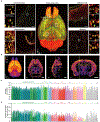Whole-Brain Profiling of Cells and Circuits in Mammals by Tissue Clearing and Light-Sheet Microscopy
- PMID: 32380050
- PMCID: PMC7213014
- DOI: 10.1016/j.neuron.2020.03.004
Whole-Brain Profiling of Cells and Circuits in Mammals by Tissue Clearing and Light-Sheet Microscopy
Abstract
Tissue clearing and light-sheet microscopy have a 100-year-plus history, yet these fields have been combined only recently to facilitate novel experiments and measurements in neuroscience. Since tissue-clearing methods were first combined with modernized light-sheet microscopy a decade ago, the performance of both technologies has rapidly improved, broadening their applications. Here, we review the state of the art of tissue-clearing methods and light-sheet microscopy and discuss applications of these techniques in profiling cells and circuits in mice. We examine outstanding challenges and future opportunities for expanding these techniques to achieve brain-wide profiling of cells and circuits in primates and humans. Such integration will help provide a systems-level understanding of the physiology and pathology of our central nervous system.
Copyright © 2020 Elsevier Inc. All rights reserved.
Conflict of interest statement
Declaration of Interests H.R.U. is a co-inventor on patent applications covering the CUBIC reagents and a cofounder of CUBICStars Inc. P.J.K. is a co-inventor on patents and patent applications covering multi-view and adaptive light-sheet microscopy. P.O. is a cofounder of Certerra Inc. and Certego Therapeutics Inc.
Figures





References
-
- Ahrens MB, Orger MB, Robson DN, Li JM, and Keller PJ (2013). Whole-brain functional imaging at cellular resolution using light-sheet microscopy. Nat Methods 10, 413–420. - PubMed
-
- Amiya T, and Tanaka T (1987). Phase transitions in crosslinked gels of natural polymers. Macromolecules 20, 1162–1164.
-
- Antonio A (1949). Quantitative researches on the optical properties of human bone. Nature 163, 604. - PubMed
Publication types
MeSH terms
Grants and funding
LinkOut - more resources
Full Text Sources
Other Literature Sources

